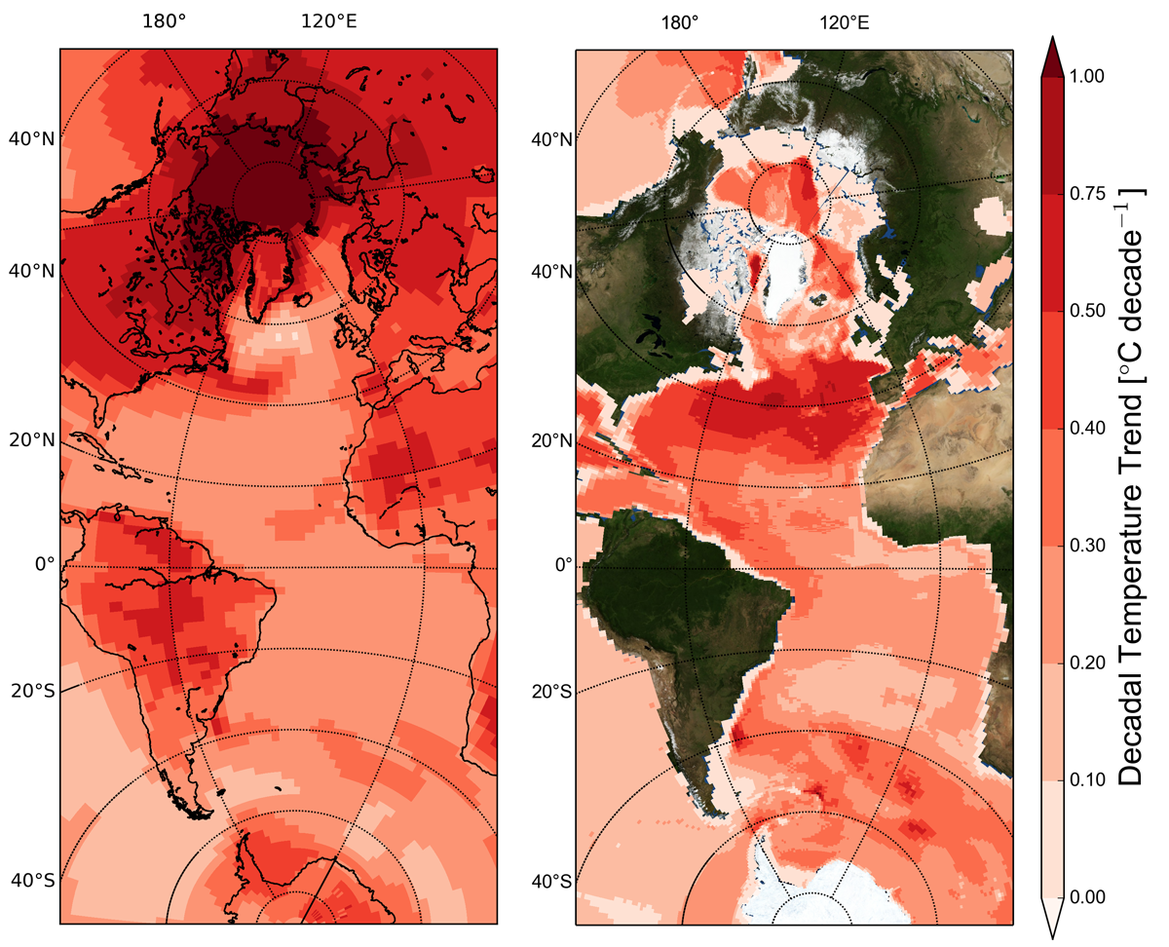Different places warm at different paces
Ocean heat transport links subpolar and Arctic warming, but that is not the whole story, writes Aleksi Nummelin. Read his account of how he, Camille Li and Paul Hezel worked to solve a climate riddle.

Main content
Ocean heat transport links together the subpolar and Arctic warming – but it’s not the whole story. About a year ago Camille, Paul and I realized that something was missing in our understanding of the ocean’s role for Arctic warming, and it was time to find out! Here is our story:
One of the robust features of global warming under increasing greenhouse gas concentrations is that different places warm at different paces.
Observations had already shown that the Earth’s surface warms fastest in the polar regions and slowest in the tropics. On the other hand, observations and model results had revealed that the ocean warms fastest over midlatitudes and the Arctic (Levitus et al. 2012, Wu et al. 2012, Armour et al. 2016).
Indeed, the pattern of ocean warming is not quite the same as the pattern of atmospheric warming. What is causing the ocean warming to follow a different pattern than the atmospheric warming, and how are the two linked?
We set out to answer these questions by exploring climate model simulations over the ongoing century. We started out by constructing a heat budget for the global ocean in the Norwegian Earth System model (NorESM), a fully coupled ocean-atmosphere model used in Norway. The model results clearly agreed with the observational data; the ocean was warming fastest in the midlatitudes and in the Arctic.
So why such a pattern? The next step was to look into the exchange of energy through the ocean surface in NorESM and in other climate models.
It turns out that the fast warming in each region had its own cause.
In the northern midlatitudes, the ocean warms quickly because more sunlight reaches the surface ocean. This happens because the subtropical high pressure region to the south expands northward and pushes away the cloudy skies.
This northward expansion of the subtropical high pressure region is really another somewhat complex story, but a short version goes roughly like this: Normally air rises in the tropics and descends in the subtropics, but global warming generally forces air upward (warm air is light) and acts against the descending motion in the subtropics. Since the air has to descend somewhere the descending branch of the circulation simply moves further north. NorESM simulations also revealed that, as a response to the circulation changes in the atmosphere, the whole subtropical ocean gyre moves slightly northward as well.
The Arctic Ocean is warming because it receives more heat from the subpolar oceans, which are warming because they are losing less heat to the warming atmosphere above. This was one of the important results of our study as we noted that the Arctic ocean warming was linked to the subpolar atmospheric warming, and not to the mid-latitude ocean warming.
In order to understand the subpolar to Arctic linkage in detail it helps to first consider the annual mean picture of ocean-atmosphere interaction at these northern latitudes. In the mean the relatively warm ocean loses heat to the relatively cold atmosphere above. However, under global warming, the atmosphere warms much faster than the ocean surface and as a result the ocean heat loss weakens. In a way the atmosphere does not need as much heat from the ocean as it did before and the ocean is happy to keep the heat. The extra heat does not remain in the subpolar oceans, but it is delivered to the Arctic by ocean circulation, not unlike the way the rapidly warming midlatitude Southern Ocean has been gaining its extra heat.
Indeed, last year Armour et al. showed that an atmospheric warming signal in the subpolar Southern Ocean moves to the rapidly warming southern midlatitudes with the equatorward ocean circulation. Our analysis of the climate model results show that locally in the rapidly warming southern midlatitudes, the atmosphere even acts against the ocean warming as the surface ocean loses an increasing amount of heat to the atmosphere.
With these results at hand we got excited. There was an oceanic linkage from the subpolar region to the Arctic that could potentially also link the atmospheric warming in these two regions.
As noted in the very beginning, one of the robust features of global warming is the relatively slow warming in the tropics and relatively fast warming in the Arctic. This phenomenon is known as Arctic amplification, and it is caused by several rather well understood mechanisms, although their relative importance is still discussed.
What is less well understood, however, is why models disagree on the amount of Arctic amplification that occurs under global warming. The most recent climate model estimates span a range between 2 to 5 times more warming in the Arctic than in the tropics.
Since one of the causes of Arctic amplification is the reduction in sea ice cover, we hypothesized that the mechanism connecting the subpolar region and the Arctic could be the following: As the ocean loses less heat to the atmosphere in the subpolar region, it remains relatively warm as the waters flow to the Arctic. The warmer waters flow northward and consequently the ocean also freezes up much further north, pushing the sea ice edge northward.
Because the atmosphere receives more heat from open water than from ice covered ocean, the atmospheric warming is amplified in the areas of sea ice loss. With this possibility in mind we went back to the climate model results and noticed that a reduced subpolar heat loss was indicative of an increase in the ocean heat loss in the Arctic, leading to strong Arctic amplification.
The ocean connected the Arctic to the subpolar region! After this realization, the pieces of the story started to fall in place.
As the atmosphere warms over the subpolar region more heat is left for the ocean to carry to the Arctic. Part of the extra heat carried by the ocean is released back to the atmosphere within the Arctic, explaining some of the differences in Arctic amplification between the models.
Yet one unanswered question came up. As we performed the model analysis we realized that the atmospheric warming in the Arctic was more tightly connected to the atmospheric warming in the subpolar region than our oceanic connection suggested. While the ocean linkage was clearly viable, something more seemed to be at play.
While we were unable to pinpoint a reason for the strong connection we hope it serves as an inspiration for future studies.
If you'd like to read more about this, the full article is here.
This is also publised at the web-pages of The Bjerknes Centre for climate research.




